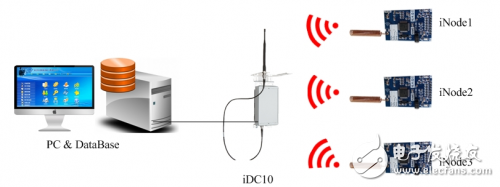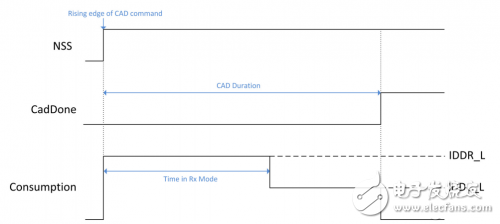The advantage of the LoRa wireless communication protocol is that it can achieve low power consumption from a long distance, but the biggest shortcoming is the slow transmission rate. In view of the long distance and low rate of LoRa, the data collector and the iNode wireless node can be organized into a star group. Net, if the reserved slot is too small, you need to re-allocate the slot.
First, a typical LoRa wireless networkThe LoRa (Long Rang) wireless communication protocol is a long-distance wireless communication technology. Its biggest advantage is that it is far away (open distance up to 15kM) and low power consumption; of course, it also has the disadvantage that the transmission rate Slow, it is best suited for wireless sensor networks, such as outdoor or cross-building (multi-floor) collection: water, electricity, temperature and humidity, carbon monoxide, smoke alarms, etc.

In view of LoRa's long distance and low rate, the Ruimi communication design: iDC10 (DataConcentrator) data collector and iNode wireless node, they can be organized into a star network, a typical wireless network topology as shown above.
iDC10 and iNode are based on "single-hop" communication, which saves iNode's valuable power, especially suitable for battery-powered applications; iDC10 can divide time into slots according to the number of iNodes, communication rate and load. The multiplexing method can maximize the use of bandwidth and avoid conflicts; iDC10 self-organizes and maintains the network, without user configuration, and is easy to use.
Second, the maximum use of bandwidthLet's look at a "competition and conflict" network communication protocol. As shown in the following figure, there are three nodes: #i, #j, and #k, which use LBT (Listen Before Talk) to listen to the channel idle mode. Access to the network, from the communication sequence diagram can be intuitively obtained 2 points:
1 Conflict brings energy loss, more delays and subsequent conflicts, such as #k originally wanted to send data frames at TI time, because it detects a collision, it can delay communication until Tk.
2 Collision will waste communication bandwidth. When the LBT detects a collision, it will use the “random delay backoff†algorithm, so that the communication time will be “fragmented†and some communication bandwidth will not be utilized.

The principle of time division multiplexing is shown in the figure below. It is a strict "step-by-step" mechanism: the communication node initiates communication in the slot allocated to itself, and the communication bandwidth is best utilized.
Time division multiplexing technology also has its own "soft rib":

1 The scalability is not strong. As more nodes are added to the network, there will be fewer slots. Therefore, it is necessary to design an algorithm to reserve a part of the slot as a “sending communication and beaconâ€; if the reserved slot is too small, it needs to be re-established. Assign a slot.
2 Clock drift brings conflicts. Although the crystal oscillator is already “accurate†in people's eyes, the production process, temperature and aging will cause individual differences in accuracy. This drift will cause node communication to conflict, resulting in time division multiplexing. The algorithm failed.
In order to cope with the above challenges, Ruimi Communication skillfully uses the "safe distance" algorithm, which calculates the reasonable value of the slot according to the number of nodes and the maximum drift coefficient of the clock, and designs the second-level school of "node active upload". The millisecond level of "collector wake up" and "beacon frame".
Third, the best energy-saving designiDC10 uses LoRa's CAD (Channel AcTIvity DetecTIon) function in wake-up iNode communication. It is an energy-saving tool for implementing LBT technology. As shown in the following figure, CAD is divided into two stages: IDDR: captures a symbol duration signal from the air. The consumption is equal to the RX mode, that is, 12 mA; IDDC: analyzes the symbol signal, checks whether the channel is idle, and consumes half of the RX mode (RF is turned off, only digital calculation).

In a wireless communication network, in many cases, nodes are “white listening†(ready to wake up into the RX state, but the channel is actually idle) and consume energy. Who can “listen as quickly as possibleâ€, who is more energy-efficient .
According to our testing experience, using CAD to quickly listen, saves 3 to 4 times more power than simply receiving an address is its own data frame.
Fourth, easy to use and low costThe network organization of the iDC10 and the iNode is only required once, and is automatically completed. There is only one condition. The iDC10 is powered on first, and the parameters (such as the number of iNodes, the length of the reported data, the reporting interval, etc.) are configured. After the iNodes are powered on, They will actively apply for access to the network with iDC10, which is the "competition" mode, the principle is shown below.

Once the network is organized, the iDC10 and iNode will save the network information without being affected by the power-on. At the same time, some iNodes will join or leave the network, and the iDC10 will maintain the allocation and recovery network address.
When the iNode transmits the collected sensor data to the iDC10 at the "slot" time, the iDC10 will "transfer" to the user system and then store and process it by the user system.
Brand Vape Pen,Aivono Vape,Abar Vape,Bounce Vape
Shenzhen Uscool Technology Co., Ltd , https://www.uscoolvape.com